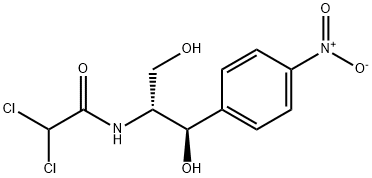Chloramphenicol , Used for plant cell culture , 56-75-7
Synonym(s):
Chloramphenicol;CAF;Chloromycetin;GCN5;GCN5L
CAS NO.:56-75-7
Empirical Formula: C11H12Cl2N2O5
Molecular Weight: 323.13
MDL number: MFCD00078159
EINECS: 200-287-4
| Pack Size | Price | Stock | Quantity |
| 25G | RMB239.20 | In Stock |
|
| 100G | RMB671.20 | In Stock |
|
| others | Enquire |
PRODUCT Properties
| Melting point: | 148-150 °C(lit.) |
| Boiling point: | 644.9±55.0 °C(Predicted) |
| alpha | 19.5 º (c=6, EtOH) |
| Density | 1.6682 (rough estimate) |
| refractive index | 20 ° (C=5, EtOH) |
| Flash point: | 14 °C |
| storage temp. | Keep in dark place,Inert atmosphere,2-8°C |
| solubility | absolute ethanol: soluble5-20mg/mL (as a stock solution) |
| pka | 11.03±0.46(Predicted) |
| form | powder |
| color | white |
| Water Solubility | 2.5 g/L (25 º C) |
| Merck | 14,2077 |
| BRN | 2225532 |
| BCS Class | 3 |
| InChIKey | WIIZWVCIJKGZOK-RKDXNWHRSA-N |
| LogP | 1.140 |
| CAS DataBase Reference | 56-75-7(CAS DataBase Reference) |
| IARC | 2A (Vol. Sup 7, 50) 1990 |
| NIST Chemistry Reference | Chloramphenicol(56-75-7) |
| EPA Substance Registry System | Chloramphenicol (56-75-7) |
Description and Uses
Chloramphenicol was originally produced by fermentation of Streptomyces venezuelae, but its comparatively simple chemical structure soon resulted in several efficient total chemical syntheses. With two asymmetric centers, it is one of four diastereomers, only one of which (1R,2R) is significantly active. Because total synthesis produces a mixture of all four, the unwanted isomers must be removed before use. Chloramphenicol is a neutral substance that is only moderately soluble in water, because both nitrogen atoms are nonbasic under physiologic conditions (one is an amide and the other a nitro moiety). It was the first broad-spectrum oral antibiotic used in the United States and was once very popular. Severe potential blood dyscrasia has greatly decreased its use in North America. Although its cheapness and efficiency makes it still very popular in much of the rest of the world where it can often be purchased over-the-counter without a prescription
antibacterial, antirickettsial, inhibits protein synthesis
Safety
| Symbol(GHS) |   GHS05,GHS08 |
| Signal word | Danger |
| Hazard statements | H318-H351-H361fd |
| Precautionary statements | P202-P280-P305+P351+P338-P308+P313-P405-P501 |
| Hazard Codes | T,F |
| Risk Statements | 45-11-39/23/24/25-23/24/25 |
| Safety Statements | 53-45-16-36/37 |
| RIDADR | 2811 |
| WGK Germany | 3 |
| RTECS | AB6825000 |
| F | 3-10 |
| TSCA | Yes |
| HazardClass | 3 |
| HazardClass | IRRITANT |
| HS Code | 29414000 |
| Hazardous Substances Data | 56-75-7(Hazardous Substances Data) |
| Toxicity | LD50 oral in rat: 2500mg/kg |



